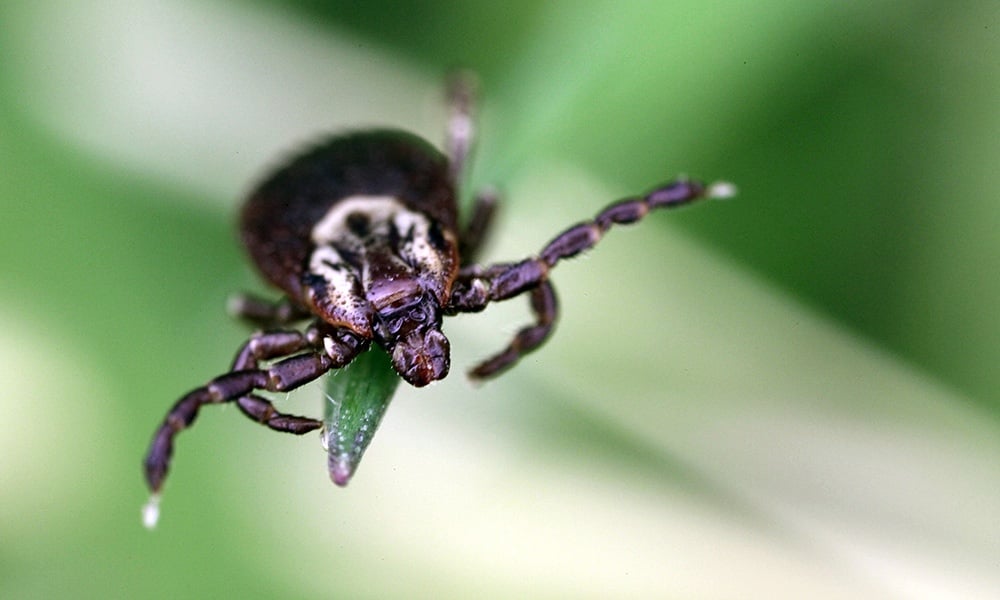
We need to talk. It’s going to be awkward, but it’s best for everyone if we just put it out there: ticks are all around you.
Ticks are an uncomfortable truth in Illinois, with multiple species found in every county throughout the state. The most common — the American dog tick (Dermacentor variabilis), sometimes called the wood tick — is found in a variety of habitats, including trail edges, grassy fields, and woodland borders.
DuPage is also home to one of the most abundant, and concerning, species of tick: The black-legged tick (Ixodes scapularis), sometimes called the deer tick. This species lives in woodlands and is of great concern because it carries Lyme disease.
Black-legged ticks don’t jump, fly, or fall from trees. They crawl — really slowly — and always start low on the body (ankle to knee height) in search of a good spot to feed. In their earliest life stage in spring and summer, the larvae look for a small host, something like a bird or mouse. They feed, molt into a nymph, and then go dormant for the rest of the year. In their second year, these nymphs become active in spring, searching for their next, much larger, meal. Raccoons, deer, dogs, and, yes, humans are now on the menu.
This is why we’re at the greatest risk in spring: Not because the nymphs can infect at higher rates or are more prone to bite than in other life stages, but because their small size often escapes detection. It usually takes 24 - 48 hours after they bite to start feeding (and possibly transmitting disease), so the longer they stay on, the more likely they are to begin feeding and pass on any diseases they’re carrying.
Defense is Offense
Thankfully, there are some simple, common-sense steps you can take to protect yourself from tick bites throughout the year. First, avoid woodlands in spring, when the nymphs of black-legged ticks are out feeding. If you do go into areas that may have ticks, wear light-colored clothing so you can easily spot them.
.jpg?width=409&height=492&name=640px-Adult_deer_tick(cropped).jpg)
Also, tuck your pants into your socks, and your shirt into your pants to keep ticks from moving from your clothes onto your body. To keep ticks from climbing onto your clothes, walk in the middle of paths and avoid brushing against vegetation. It also helps to apply insect repellent containing 20 – 30% DEET to your clothing to keep ticks away.
When you get home, put your clothes in the dryer on high heat for 30+ minutes to kill any ticks. But the most important thing you can do to prevent tick bites is also the easiest: Check yourself thoroughly every time you go outside in potential tick habitat. Early detection is key to avoiding tick bites and removing attached ticks before disease transmission.
Sometimes, even if you take these precautions, you still may find an attached tick. If you do have to remove a tick, there’s a simple way to do so:
● Don’t burn, smother, or put oil on the tick. These won’t kill it, but may force the tick to burrow in deeper.
● Grasp the tick as close as possible to your skin using a pair of forceps or tweezers.
● Slowly but firmly pull the tick straight out, don’t twist or yank it out. This will make sure you don’t break it and leave the mouthparts still attached.
● Once the tick is removed, clean the area and your hands thoroughly.

After removal, the most important thing to do is monitor the site. It takes 3 – 30 days before Lyme disease symptoms start showing. Symptoms include general fever-like symptoms as well as a distinct bullseye-looking rash. If you have any of these symptoms or any other concerns, call your physician.
So remember, even though they’re all around us, with just a few simple precautions you can protect yourself from those pesky ticks and enjoy a wonderful summer!
For more information about ticks, please visit our website.
Image Credit: Scott Bauer, via Wikimedia Commons
Andres Ortega
